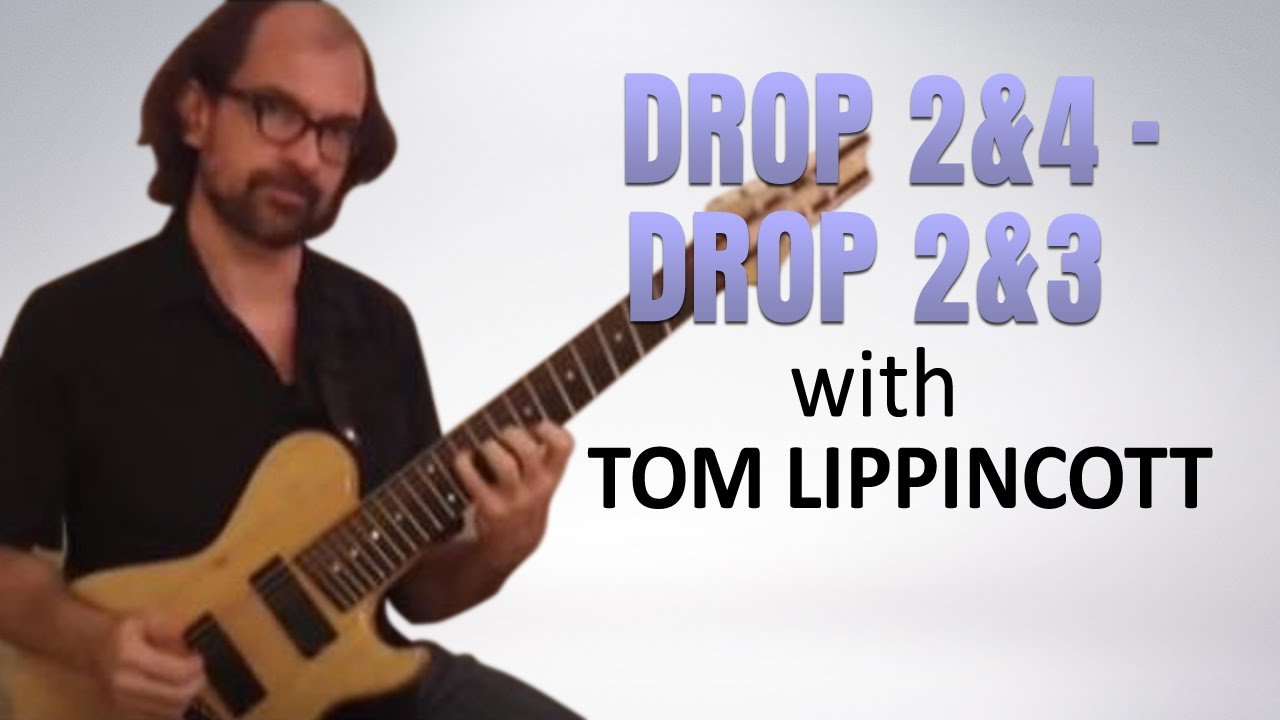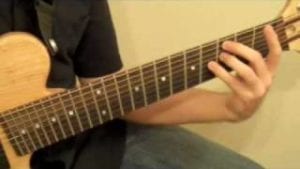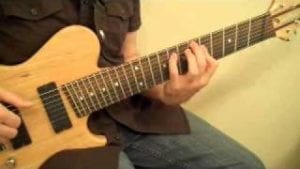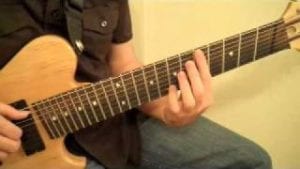Description
The Advanced Jazz Guitar Harmony series begins where the Jazz Guitar Harmony series left off. Unlike the first series, which consisted of parts 1-5, and was designed primarily to be worked with in sequential order, each class in the Advanced Jazz Guitar Harmony series is complete unto itself and explores one specific subject in depth. Classes in this series are intended for the intermediate to advanced jazz guitarist who has either completed the five classes of the Jazz Guitar Harmony series or who already has a working command of the basics of typical jazz guitar harmonic vocabulary.
In this class, two specific types of chord voicings, drop 2&4 and drop 2&3 will be examined in detail. The term “voicing” refers to how the notes are arranged in a chord. Many of the typical stock jazz guitar chords are shell voicings, close voicings, drop 2, and drop 3, all of which are explored in clear, systematic detail in the Jazz Guitar Harmony series. Drop 2&4 and drop 2&3 are two other possible chord voicings which are a little more off the beaten track for most jazz guitarists. These voicings have a unique and intriguing sound due to their relatively large spans and, in some cases, unusual intervallic combinations, and yet most of them are just as playable and practical for every day use as the more mainstream types.
Until recently, few, if any, of these voicings were in common use among jazz guitarists. Even though the latest generation of modern jazz guitar masters in the early 21st century have begun to make use of them more often, both the drop 2&4 and the drop 2&3 voicings remain less utilized than other voicing types. This means that these voicings contain a wealth of new, unexplored possibilities for guitarists looking for fresh sounds to add to their harmonic vocabulary.
The basics of drop 2&4 and drop 2&3 voicings were touched upon briefly in part 3 of my Modern Jazz Guitar series, but now we will delve into that sound in detail. This new class provides a logical, systematic step-by-step approach for finding the drop 2&4 and drop 2&3 seventh chord voicings derived from the major scale, the seventh chords unique to the harmonic and melodic minor scales, and the embellishment of these voicings with color tones. Numerous musical examples are demonstrated on the video as well as written out in traditional notation and chord grid form, but the material has been designed to be open-ended enough that you will be encouraged to find your own path and work toward developing your unique musical voice
Advanced Jazz Guitar Harmony, Drop 2&4, Drop 2&3, covers:
- review of the basics of the drop system for voicing 7th chords, including examples of conversion of close position chords to commonly played drop 2, drop 3 voicings
- explanation and demonstration of drop 2&4 and drop 2&3 voicings
- in depth discussion of the concept of chord inversion, including both “piano” and “choir” methods, and their application to drop 2&4 and drop 2&3 voicings
- hints to make learning the new voicings easier
- demonstration with written examples and close-up fingerboard view of all inversions and string sets for drop 2&4 and drop 2&3 voicings
- discussion of right hand techniques for chordal playing, including pick, pick and fingers combined, and finger style
- drop 2&4 and drop 2&3 version of the “chord scale exercise” which is a logical and musical presentation of voicings by inversion and string set, covering all the 7th chords diatonic to the major scale, with subtitles on the video that match each exercise to the written example
- development of additional fluidity with the voicings is explored by taking the voicings through diatonic cycles similar to those included in the Jazz Guitar Harmony series (includes a brief review of the diatonic cycle concept)
- discussion of method for finding the drop 2&4 and drop 2&3 voicings for harmonies unique to the harmonic and melodic minor scales, with examples and suggestions for practice
- techniques for adding color tones to the voicings with examples, along with the “color tone replacement chart” from the Jazz Guitar Harmony 5 class
- comping etude written on the chord changes to the standard tune “The Will Never Be Another You” utilizing the drop 2&4 and drop 2&3 voicings in a musical context, with notated comping rhythms, demonstration of use of color tones, contrapuntal movement, and use of diatonic and melodic minor reharmonization techniques
- running time: 128 minutes
- includes 18 pages of written examples and exercises provided in standard notation, tablature, and chord grids
Jazz Guitar Harmony Series:
- Jazz Guitar Harmony Part V
- Jazz Guitar Harmony Part IV
- Jazz Guitar Harmony Part III
- Jazz Guitar Harmony Part II
- Jazz Guitar Harmony Part I
Advanced Jazz Guitar Harmony: Drop 2 and 4, Drop 2 and 3 Class Content | Tom Lippincott
The Advanced Jazz Guitar Harmony series begins where the Jazz Guitar Harmony series left off. Unlike the first series, which consisted of parts 1-5, and was designed primarily to be worked with in sequential order, each class in the Advanced Jazz Guitar Harmony series is complete unto itself and explores one specific subject in depth.
Classes in this series are intended for the intermediate to advanced jazz guitarist who has either completed the five classes of the Jazz Guitar Harmony series or who already has a working command of the basics of typical jazz guitar harmonic vocabulary.
The Drop 2&4 and Drop 2&3 Chord Voicings
In this class, two specific types of chord voicings, drop 2&4 and drop 2&3 will be examined in detail. The term “voicing” refers to how the notes are arranged in a chord.
Many of the typical stock jazz guitar chords are shell voicings, close voicings, drop 2, and drop 3, all of which are explored in clear, systematic detail in the Jazz Guitar Harmony series. Drop 2&4 and drop 2&3 are two other possible chord voicings which are a little more off the beaten track for most jazz guitarists.
These voicings have a unique and intriguing sound due to their relatively large spans and, in some cases, unusual intervallic combinations, and yet most of them are just as playable and practical for every day use as the more mainstream types.
Usage In Modern Jazz Guitar
Until recently, few, if any, of these voicings were in common use among jazz guitarists. Even though the latest generation of modern jazz guitar masters in the early 21st century have begun to make use of them more often, both the drop 2 and 4 and the drop 2 and 3 voicings on guitar remain less utilized than other voicing types. This means that these voicings contain a wealth of new, unexplored possibilities for guitarists looking for fresh sounds to add to their harmonic vocabulary.
The basics of drop 2&4 and drop 2&3 voicings were touched upon briefly in part 3 of my Modern Jazz Guitar series, but now we will delve into that sound in detail. This new class provides a logical, systematic step-by-step approach for finding the drop 2&4 and drop 2&3 seventh chord voicings derived from the major scale, the seventh chords unique to the harmonic and melodic minor scales, and the embellishment of these voicings with color tones.
Numerous musical examples are demonstrated on the video as well as written out in traditional notation and chord grid form, but the material has been designed to be open-ended enough that you will be encouraged to find your own path and work toward developing your unique musical voice
If you are looking for a free download to this course, check out the complete advanced guitar video found here on the Mike’s Master Classes youtube channel.
Advanced Jazz Guitar Harmony, Drop 2&4, Drop 2&3, covers:
- review of the basics of the drop system for voicing 7th chords, including examples of conversion of close position chords to commonly played drop 2, drop 3 voicings
- explanation and demonstration of drop 2&4 and drop 2&3 voicings
- in depth discussion of the concept of chord inversion, including both “piano” and “choir” methods, and their application to drop 2&4 and drop 2&3 voicings
- hints to make learning the new voicings easier
- demonstration with written examples and close-up fingerboard view of all inversions and string sets for drop 2&4 and drop 2&3 voicings
- discussion of right hand techniques for chordal playing, including pick, pick and fingers combined, and finger style
- drop 2&4 and drop 2&3 version of the “chord scale exercise” which is a logical and musical presentation of voicings by inversion and string set, covering all the 7th chords diatonic to the major scale, with subtitles on the video that match each exercise to the written example
- development of additional fluidity with the voicings is explored by taking the voicings through diatonic cycles similar to those included in the Jazz Guitar Harmony series (includes a brief review of the diatonic cycle concept)
- discussion of method for finding the drop 2&4 and drop 2&3 voicings for harmonies unique to the harmonic and melodic minor scales, with examples and suggestions for practice
- techniques for adding color tones to the voicings with examples, along with the “color tone replacement chart” from the Jazz Guitar Harmony 5 class
- comping etude written on the chord changes to the standard tune “The Will Never Be Another You” utilizing the drop 2&4 and drop 2&3 voicings in a musical context, with notated comping rhythms, demonstration of use of color tones, contrapuntal movement, and use of diatonic and melodic minor reharmonization techniques
- running time: 128 minutes
- includes 18 pages of written examples and exercises provided in standard notation, tablature, and chord grids
Jazz Guitar Harmony Series:
| Advanced Jazz Guitar Harmony: Drop 2 and 4, Drop 2 and 3 | |||
| Advanced Jazz Guitar Harmony: Drop 2 and 4, Drop 2 and 3 | 02:08:00 | ||








